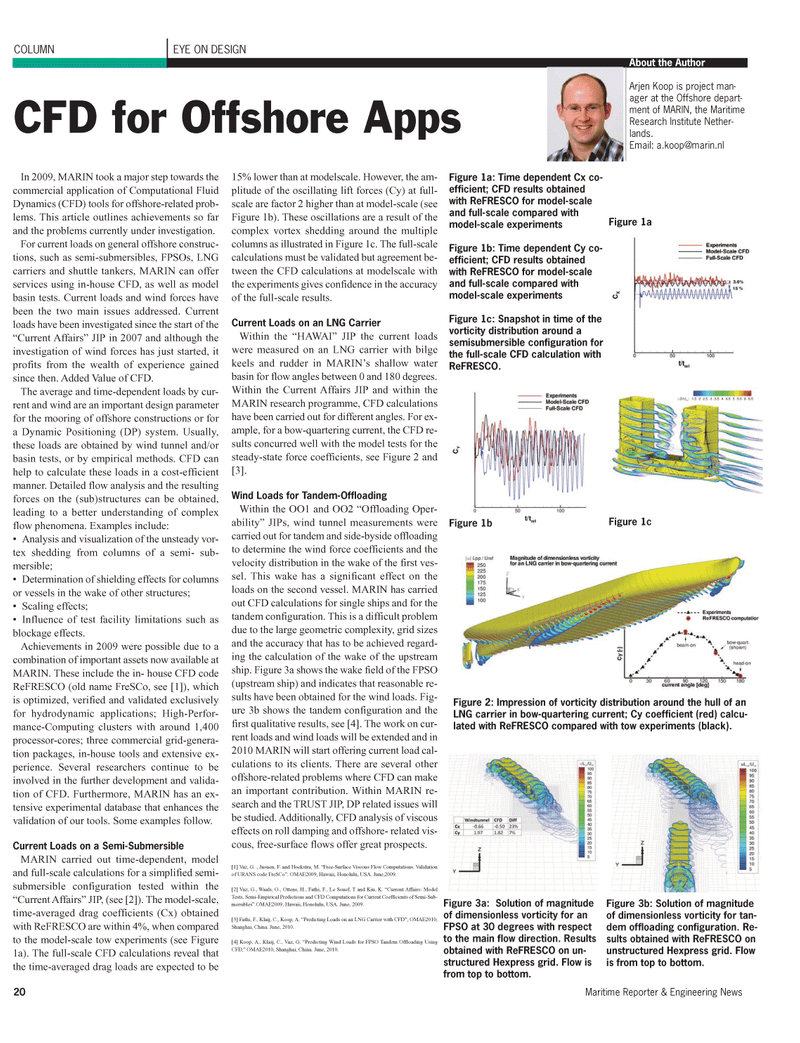
Page 20: of Maritime Reporter Magazine (August 2010)
The Electric Ship
Read this page in Pdf, Flash or Html5 edition of August 2010 Maritime Reporter Magazine
20 Maritime Reporter & Engineering News
In 2009, MARIN took a major step towards the commercial application of Computational Fluid
Dynamics (CFD) tools for offshore-related prob- lems. This article outlines achievements so far and the problems currently under investigation.
For current loads on general offshore construc- tions, such as semi-submersibles, FPSOs, LNG carriers and shuttle tankers, MARIN can offer services using in-house CFD, as well as model basin tests. Current loads and wind forces have been the two main issues addressed. Current loads have been investigated since the start of the “Current Affairs” JIP in 2007 and although the investigation of wind forces has just started, it profits from the wealth of experience gained since then. Added Value of CFD.
The average and time-dependent loads by cur- rent and wind are an important design parameter for the mooring of offshore constructions or for a Dynamic Positioning (DP) system. Usually, these loads are obtained by wind tunnel and/or basin tests, or by empirical methods. CFD can help to calculate these loads in a cost-efficient manner. Detailed flow analysis and the resulting forces on the (sub)structures can be obtained, leading to a better understanding of complex flow phenomena. Examples include: • Analysis and visualization of the unsteady vor- tex shedding from columns of a semi- sub- mersible; • Determination of shielding effects for columns or vessels in the wake of other structures; • Scaling effects; • Influence of test facility limitations such as blockage effects.
Achievements in 2009 were possible due to a combination of important assets now available at
MARIN. These include the in- house CFD code
ReFRESCO (old name FreSCo, see [1]), which is optimized, verified and validated exclusively for hydrodynamic applications; High-Perfor- mance-Computing clusters with around 1,400 processor-cores; three commercial grid-genera- tion packages, in-house tools and extensive ex- perience. Several researchers continue to be involved in the further development and valida- tion of CFD. Furthermore, MARIN has an ex- tensive experimental database that enhances the validation of our tools. Some examples follow.
Current Loads on a Semi-Submersible
MARIN carried out time-dependent, model and full-scale calculations for a simplified semi- submersible configuration tested within the “Current Affairs” JIP, (see [2]). The model-scale, time-averaged drag coefficients (Cx) obtained with ReFRESCO are within 4%, when compared to the model-scale tow experiments (see Figure 1a). The full-scale CFD calculations reveal that the time-averaged drag loads are expected to be 15% lower than at modelscale. However, the am- plitude of the oscillating lift forces (Cy) at full- scale are factor 2 higher than at model-scale (see
Figure 1b). These oscillations are a result of the complex vortex shedding around the multiple columns as illustrated in Figure 1c. The full-scale calculations must be validated but agreement be- tween the CFD calculations at modelscale with the experiments gives confidence in the accuracy of the full-scale results.
Current Loads on an LNG Carrier
Within the “HAWAI” JIP the current loads were measured on an LNG carrier with bilge keels and rudder in MARIN’s shallow water basin for flow angles between 0 and 180 degrees.
Within the Current Affairs JIP and within the
MARIN research programme, CFD calculations have been carried out for different angles. For ex- ample, for a bow-quartering current, the CFD re- sults concurred well with the model tests for the steady-state force coefficients, see Figure 2 and [3].
Wind Loads for Tandem-Offloading
Within the OO1 and OO2 “Offloading Oper- ability” JIPs, wind tunnel measurements were carried out for tandem and side-byside offloading to determine the wind force coefficients and the velocity distribution in the wake of the first ves- sel. This wake has a significant effect on the loads on the second vessel. MARIN has carried out CFD calculations for single ships and for the tandem configuration. This is a difficult problem due to the large geometric complexity, grid sizes and the accuracy that has to be achieved regard- ing the calculation of the wake of the upstream ship. Figure 3a shows the wake field of the FPSO (upstream ship) and indicates that reasonable re- sults have been obtained for the wind loads. Fig- ure 3b shows the tandem configuration and the first qualitative results, see [4]. The work on cur- rent loads and wind loads will be extended and in 2010 MARIN will start offering current load cal- culations to its clients. There are several other offshore-related problems where CFD can make an important contribution. Within MARIN re- search and the TRUST JIP, DP related issues will be studied. Additionally, CFD analysis of viscous effects on roll damping and offshore- related vis- cous, free-surface flows offer great prospects. [1] Vaz, G. , Jaouen, F. and Hoekstra, M. “Free-Surface Viscous Flow Computations. Validation of URANS code FreSCo”. OMAE2009, Hawaii, Honolulu, USA. June,2009. [2] Vaz, G., Waals, O., Ottens, H., Fathi, F., Le Souef, T and Kiu, K. “Current Affairs: Model
Tests, Semi-Empirical Predictions and CFD Computations for Current Coefficients of Semi-Sub- mersibles”.OMAE2009, Hawaii, Honolulu, USA. June, 2009. [3] Fathi, F., Klaij, C., Koop, A. “Predicting Loads on an LNG Carrier with CFD”, OMAE2010,
Shanghai, China. June, 2010. [4] Koop, A., Klaij, C., Vaz, G. “Predicting Wind Loads for FPSO Tandem Offloading Using
CFD,” OMAE2010, Shanghai, China. June, 2010.
COLUMN EYE ON DESIGN
CFD for Offshore Apps
About the Author
Arjen Koop is project man- ager at the Offshore depart- ment of MARIN, the Maritime
Research Institute Nether- lands.
Email: [email protected]
Figure 1a: Time dependent Cx co- efficient; CFD results obtained with ReFRESCO for model-scale and full-scale compared with model-scale experiments
Figure 1b: Time dependent Cy co- efficient; CFD results obtained with ReFRESCO for model-scale and full-scale compared with model-scale experiments
Figure 1c: Snapshot in time of the vorticity distribution around a semisubmersible configuration for the full-scale CFD calculation with
ReFRESCO.
Figure 2: Impression of vorticity distribution around the hull of an
LNG carrier in bow-quartering current; Cy coefficient (red) calcu- lated with ReFRESCO compared with tow experiments (black).
Figure 3b: Solution of magnitude of dimensionless vorticity for tan- dem offloading configuration. Re- sults obtained with ReFRESCO on unstructured Hexpress grid. Flow is from top to bottom.
Figure 3a: Solution of magnitude of dimensionless vorticity for an
FPSO at 30 degrees with respect to the main flow direction. Results obtained with ReFRESCO on un- structured Hexpress grid. Flow is from top to bottom.
Figure 1a
Figure 1b
Figure 1c

 19
19

 21
21
